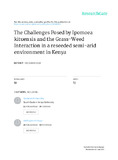The Challenges Posed by Ipomoea kituensis and the Grass-Weed Interaction in a reseeded semi-arid environment in Kenya

View/
Date
2016Author
Nyariki, Dickson M.
Mganga, K. Z.
Musimba, N.K.R.
Nyangito, M. M.
Mwang’ombe, A.W.
Ekaya, W. N.
Muiru, W. M.
Metadata
Show full item recordAbstract
Rehabilitation of denuded patches using perennial grasses has been used
extensively in semi-arid environments of Kenya. However, weeds
continue to pose an enormous challenge to the success of many
rehabilitation programmes. The aim of this study was to identify the
common weeds that pose a challenge to rehabilitation success and
establish the grass-weed interactions in rehabilitated areas of a semiarid
environment in Kenya. A survey questionnaire was administered to
capture the farmers’ perception on the most problematic weeds and the
challenge they pose to rehabilitation programmes. Experimental plots
were laid out under simulated rainfall (sprinkler system). Three
perennial grasses; Cenchrus ciliaris, Eragrostis superba, and
Enteropogon macrostachyus, were used. These grasses were sown
along ox-ploughed micro-catchments as pure stands and two grass
mixtures and monitored at three phenological stages; early vegetative
(15cm), elongation (30cm) and reproduction (60cm) representing high,
medium and low grazing intensities respectively. Results from this
survey showed Ipomoea kituensis posed the greatest challenge to
rehabilitation programmes. Results also showed an inverse relationship
in biomass yields between the weeds and established grasses across the
three phenological stages. These results strongly suggest that selective
weeding of rehabilitated semi-arid environments is critical for the
success of rehabilitation programmes in semi-arid Kenya.
URI
http://hdl.handle.net/123456789/82https://www.researchgate.net/publication/236646458_The_Challenges_Posed_by_Ipomoea_kituensis_and_the_Grass-Weed_Interaction_in_a_reseeded_semi-arid_environment_in_Kenya
Collections
- Journal Articles (BE) [401]
